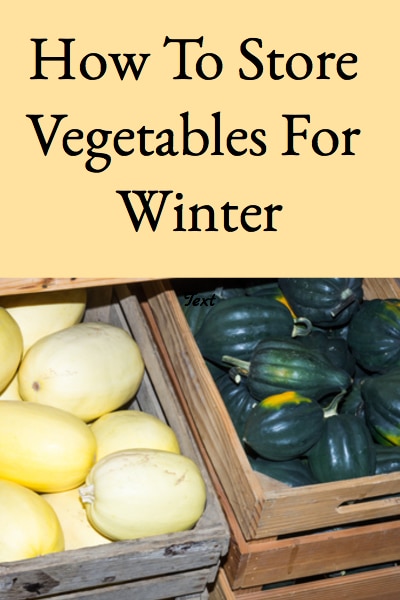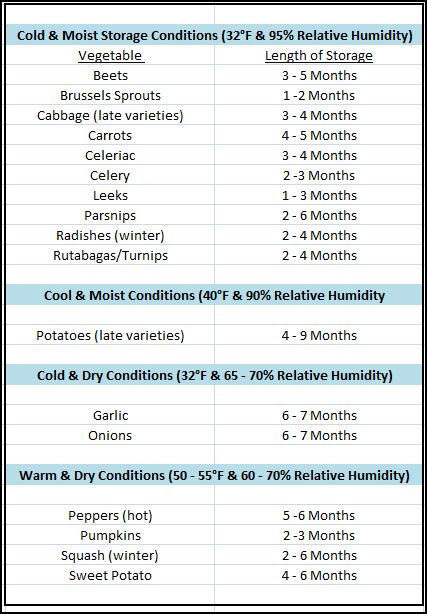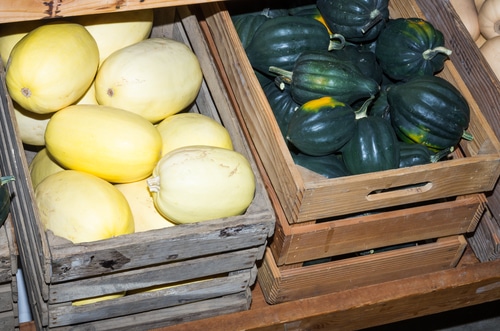It’s that time of year when the excess vegetables from the garden need to be stored before frost destroys them. The good news is, many 
Even without a garden, buying quantities of these vegetables while they’re fresh and “in season” and storing them for later winter use can make sense.
Both of these approaches provide fresh vegetables more economically than buying from the supermarket in the middle of winter when it’s most expensive. In addition, vegetables stored at their peak maturity usually have better flavor and higher nutritional value.
Choose Appropriate Vegetables & Storage Conditions
Vegetables that are good candidates for winter storage can be classified into four groups depending on the temperature and humidity conditions that are ideal for their storage.
Vegetables not included in the table below can usually only be kept in short-term storage (a few weeks) and are better processed by canning, freezing, or drying for winter use. The four groups and the long-term storage conditions are:

What Storage Materials To Use
Vegetables are usually packed in some type of material for winter storage to provide insulation or moisture retention while reducing disease transmission.
Sawdust, clean straw, dry leaves, hay, corn stalks or peat moss are often used as insulating materials for vegetables that need dry storage. Because they can become contaminated with mold and bacteria; these storage materials should be used for only one season and then they can be recycled into compost or mulch for the garden.
Vegetables that need moist storage shouldn’t be directly exposed to air and moistened sand, sawdust, or peat moss are commonly used as storage materials. Plastic bags or liners can also be used to help retain moisture but should be perforated at regular intervals to maintain air circulation and prevent condensation.
Alternating layers of produce with packing materials and wrapping items individually helps reduce disease transmission. Old newspapers have commonly been used for this purpose.
How To Ensure Storage Success
When harvesting or buying vegetables for winter storage, there are several guidelines to follow to ensure successful extended storage times:
1) Choose late-maturing varieties that are suited for long-term storage
2) Harvest or buy vegetables that are at peak maturity
3) Store only vegetables that are completely free of any visible blemishes or damage
4) Handle vegetables carefully to prevent bruising or damage
5) Leave an inch of stem on the vegetable (if possible) to minimize water loss and prevent infection
In addition to using the right temperature, humidity, and guidelines above; vegetables should be stored in dark, aerated, pest free conditions. Standing water, freezing, and storage with fruits (which give off ethylene that hastens ripening) should all be avoided.
Vegetables shouldn’t be stored until the temperature in the storage area has dropped to the appropriate level. Often, getting the vegetables into an adequately cold storage location at peak maturity is the biggest storage challenge; however, it’s essential to achieving long-term storage success.

Winter squash stored in wooden crates in the root cellar
We’ve had great success with potatoes, winter squash (see Winter Squash: Harvesting, Curing, & Storing), and many of the root vegetables; even though our storage conditions still aren’t quite ideal for long-term storage. We’re using a basement root cellar that generally isn’t as cold or moist as it should be, yet we’re still able to store a great deal to last through the winter months (the link HERE provides plans for building a proper basement storage room). There’s something so satisfying about gathering the ingredients for winter meals from what you’ve grown and stored rather than running to the supermarket!
Leave a Reply